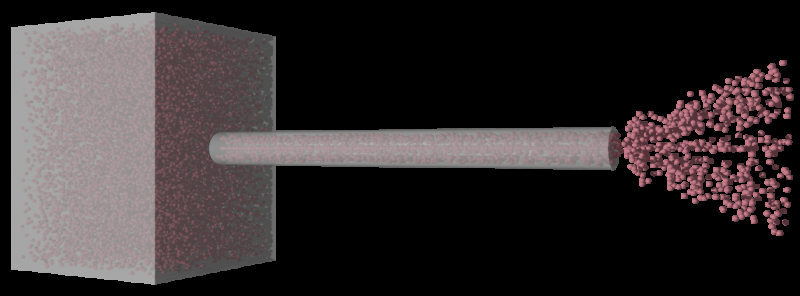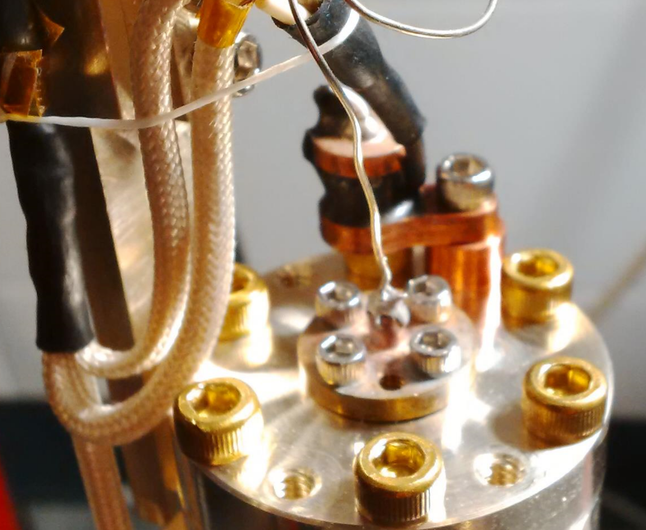Quantum physics on tap: Nano-sized faucet offers experimental support for longstanding quantum theory

We all know intuitively that normal liquids flow more quickly as the channel containing them tightens. Think of a river flowing through narrow rapids.
But what if a pipe were so amazingly tiny that only a few atoms of superfluid helium could squeeze through its opening at once? According to a longstanding quantum-mechanics model, the superfluid helium would behave differently from a normal liquid: far from speeding up, it would actually slow down.
For more than 70 years, scientists have been studying the flow of helium through ever smaller pipes. But only recently has nanotechnology made it possible to reach the scale required to test the theoretical model, known as the Tomonaga-Luttinger theory (after the scientists who developed it).
Now, a team of McGill University researchers, with collaborators at the University of Vermont and at Leipzig University in Germany, has succeeded in conducting experiments with the smallest channel yet - less than 30 atoms wide. In results published online today in Science Advances, the researchers report that the flow of superfluid helium through this miniature faucet does, indeed, appear to slow down.
"Our results suggest that a quantum faucet does show a fundamentally different behaviour," says McGill physics professor Guillaume Gervais, who led the project. "We don't have the smoking gun yet. But we think this a great step toward proving experimentally the Tomonaga-Luttinger theory in a real liquid."
The zone where physics changes
Insights from the research could someday contribute to novel technologies, such as nano-sensors with applications in GPS systems. But for now, Gervais says, the results are significant simply because "we're pushing the limit of understanding things on the nanoscale. We're approaching the grey zone where all physics changes."
Prof. Adrian Del Maestro from the University of Vermont has been employing high-performance computer simulations to understand just how small the faucet has to be before this new physics emerges. "The ability to study a quantum liquid at such diminutive length scales in the laboratory is extremely exciting as it allows us to extend our fundamental understanding of how atoms cooperate to form the superfluid state of matter," he says. "The superfluid slowdown we observe signals that this cooperation is starting to break down as the width of the pipe narrows to the nanoscale" and edges closer to the exotic one-dimensional limit envisioned in the Tomonaga-Luttinger theory.
Building what is probably the world's smallest faucet has been no simple task. Gervais hatched the idea during a five-minute conversation over coffee with a world-leading theoretical physicist. That was eight years ago. But getting the nano-plumbing to work took "at least 100 trials—maybe 200," says Gervais, who is a fellow of the Canadian Institute for Advanced Research.

A beam of electrons as drill bit
Using a beam of electrons as a kind of drill bit, the team made holes as small as seven nanometers wide in a piece of silicon nitride, a tough material used in applications such as automotive diesel engines and high-performance ball bearings. By cooling the apparatus to very low temperatures, placing superfluid helium on one side of the pore and applying a vacuum to the other, the researchers were able to observe the flow of the superfluid through the channel. Varying the size of the channel, they found that the maximum speed of the flow slowed as the radius of the pore decreased.
The experiments take advantage of a unique characteristic of superfluids. Unlike ordinary liquids - water or maple syrup, for example—superfluids can flow without any viscosity. As a result, they can course through extremely narrow channels; and once in motion, they don't need any pressure to keep going. Helium is the only element in nature known to become a superfluid; it does so when cooled to an extremely low temperature.
An inadvertent breakthrough
For years, however, the researchers were frustrated by a technical glitch: the tiny pore in the silicon nitride material kept getting clogged by contaminants. Then one day, while Gervais was away at a conference abroad, a new student in his lab inadvertently deviated from the team's operating procedure and left a valve open in the apparatus. "It turned out that this open valve kept the hole open," Gervais says. "It was the key to getting the experiment to work. Scientific breakthroughs don't always happen by design!"
More information: "Critical flow and dissipation in a quasi-one-dimensional superfluid," Pierre-François Duc, Michel Savard, Matei Petrescu, Bernd Rosenow, Adrian Del Maestro, Guillaume Gervais. Science Advances, published online May 15, 2015. 10.1126/sciadv.1400222 . advances.sciencemag.org/content/1/4/e1400222
Journal information: Science Advances
Provided by McGill University





















